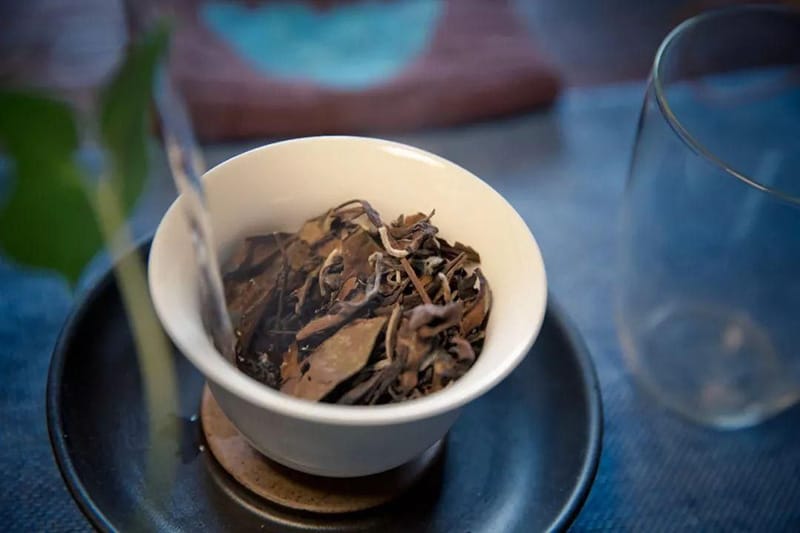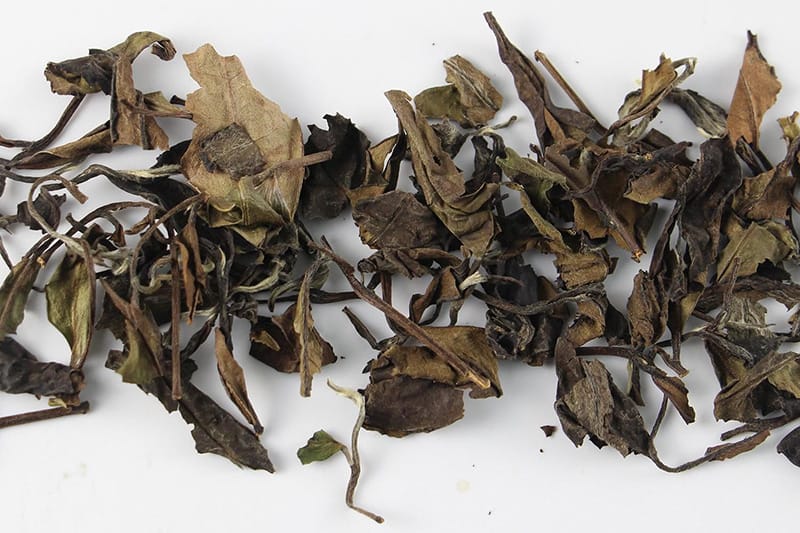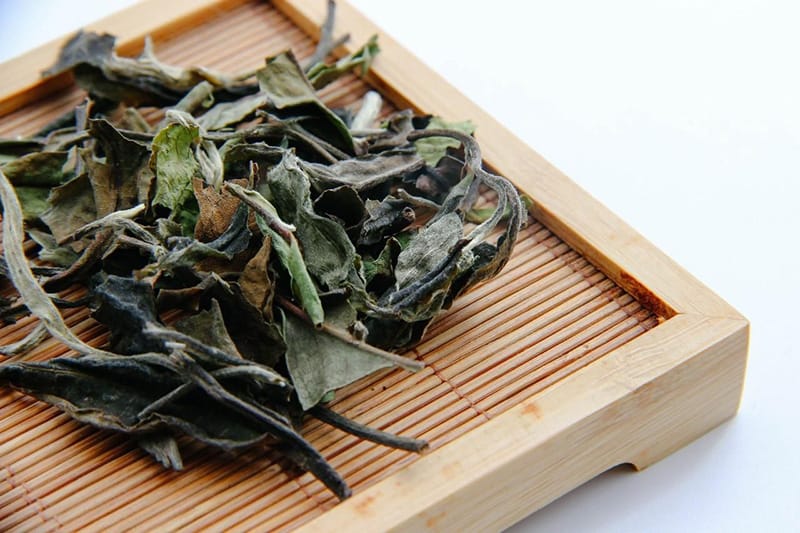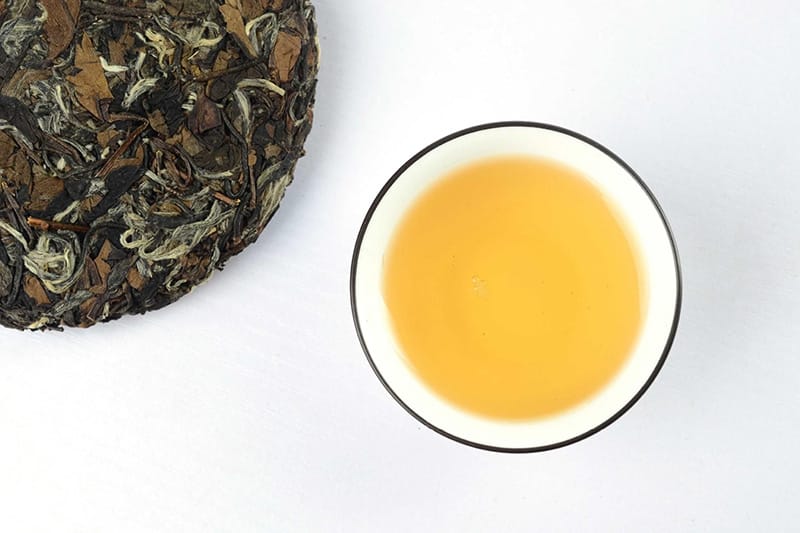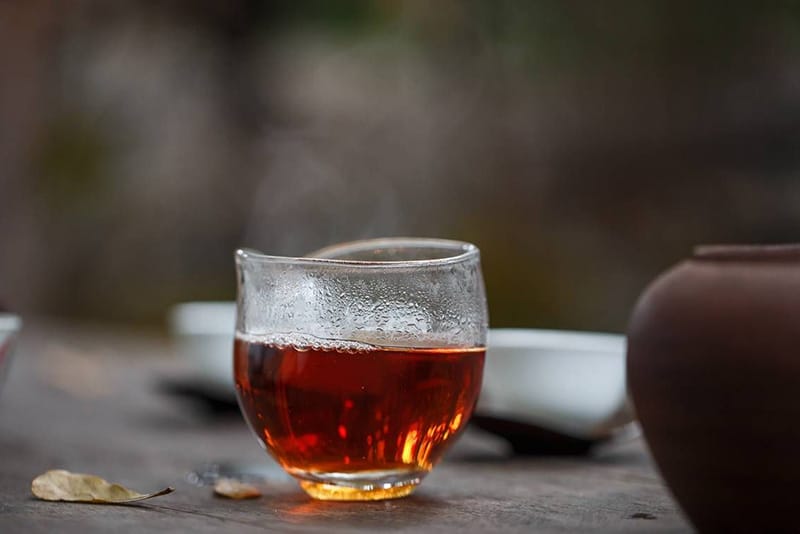Last Updated on 01/10/2021 by Desmond
In our impression, white tea may all like the Baihao Yinzhen, full of tender buds. The fuzz reflects shining silver light under the sun, noble and elegant. In the Fuding White Tea market, there also a kind that looks very ugly, but the yield over 50% of the total, and regarded as the best white tea for a beginner – Shoumei Tea.
CONTENT
What Is Shoumei Tea
White teas primarily come from two regions in China, Yunnan(moonlight white tea) and Fujian(Fuding and Zhenghe.) According to the different tea tree types and picking standards, Fujian white teas are grading into Baihao Yinzhen(silver needle,) White Peony, and Shoumei.
Shou means longevity, and Mei means eyebrow. The name of Shoumei tea comes from its leaf shape that looks like a long-living man’s eyebrow.
Shoumei white tea is made from the Dabai tea trees; the picking standard is one bud and to the fourth and the fifth leaf. It can be picked from spring to autumn. Due to the source leaves are old, and with many tea stems, Shoumei looks like withered fallen leaves; It often makes people think it’s low-quality. And to see by the leaf-grading system, Shoumei’s leaves belong to the lowest level, so people always regarded it as a low-grade tea.
Besides, the picking period of Shoumei is long(Silver needle and White Peony only picked in spring,) it provides more leaves for production. So Shoumei tea takes over 50% of white tea’s total yield, leading to a low price.
Is Shoumei Tea Really A Low-grade Tea?
Low-grade source-leaves and a low price doesn’t mean Shoumei tea also low-quality.
As a white tea, the most significant characteristic of Shoumei is it has been less processing, and more natural ingredients are retained. The leaves with stem after picked will be withering for several days, let the grassy smell go away, and get a little fermenting. Then, they will be roasted into rough tea directly.
Tea masters will screen and blend the rough tea to make the final products. In the past, the higher quality Shoumei was also called Gongmei. In the past time, there is only Gongmei but not Shoumei in the Chinese export products list; people may more familiar with this name.
Finally, tea masters will do like processing dark tea, steaming the white tea leaves to make them soft again, then compressing them into a cake. That makes Shoumei white tea allowed to be stored for a longer time, so-called aging. And the vast old leaves and stems will provide more help to the Shoumei tea aging rather. Because they contain more natural ingredients, which are the leaves aging need.
The old Shoumei tea, which aging successfully, will send out a medicine-like aroma, and the taste will also change from slight astringency to mellow. The Shoumei tea like that is one kind of high-grade tea, and it’s many tea lovers’ favorite.
It is worth noticing that Shoumei leaves can be picked from spring to autumn, and every season they are from has a different quality. Generally saying, the spring leaves got the highest quality, so the spring Shoumei is more worth for aging.
What Is Different Between Shoumei & Gongmei?
We’ve mentioned that Shoumei white tea also got another name-Gongmei. Most of the time, tea merchants will regard them as the same tea, or you can think that Gongmei is a little higher grade than Shoumei. But if serious, these two teas are totally different.
Gong means tribute in Chinese. It was said that Gongmei tea is one kind of Shoumei which only supplied to the emperor in the past. Of course, this saying without any proof. In fact, the word Gongmei appeared in about the 1950s.
At that time, both Shoumei and Gongmei were made from the Xiaobai tea trees, which was different from now. Due to the grading needs, all the high-quality source leaves were made into Gongmei; thus, Shoumei had to use the leftover and be regarded as a cheaper one. And Gongmei tea also took over 70% export volume of white tea at that time.
Till 3 years ago(2018), the Chinese government has promulgated relevant regulations: GB/T 22291-2017, definitely redefined the standard of Gongmei tea and Shoumei tea.
- Gongmei: The tea made from the buds and leaves from the population cultivar tea trees;
- Shoumei: The tea made from the buds and leaves from Dabai, Narcissus, and population cultivar tea trees;
A simple way to identify them is that Gongmei’s leaf is smaller, long and thin, and with more buds; Shoumei’s leaf and stem are bigger and with fewer buds.
Still, many tea merchants will make a mistake about Gongmei and Shoumei on the package note(intentional or unintentional.) Of course, just like we often say, low-grade doesn’t mean low-quality, both of them also worth having a try.
Fresh Shoumei VS Old Shoumei
White tea hasn’t been fixated during the processing, so the leaves will keep fermenting all the time. It makes the Shoumei tea got a big difference in flavor after a long time of aging. It is generally recognized that the Shoumei, which is stored less than one year, is fresh; been stored 1-2 years, is aged Shoumei; been stored over 3 years, is old Shoumei.
The fresh Shoumei tea flavor is partial to a faint scent, and the mouthfeel is clear and rich in irritants. But only let it be a few months aging, then you will clearly experience the flavor change. The aged Shoumei aroma begins to turn rich, faintly with some floral, and the mouthfeel becomes soft. And after a long time of aging, its flavor becomes mature, more mellow, and mild, with a strong floral and Chinese medicine aroma.
Some dishonest merchants may use the fresh Shoumei to pretend to be old Shoumei for sale. Here are several points to help you identify whether the tea is fresh or old.
- Appearance. The old Shoumei tea may get many broken leaves in the package because of the long storage time. The fuzz on the leaves mostly fallen, and the tea cake’s surface looks covered with a layer of wax. Besides, fresh Shoumei looks brown-green or grey-green; the old one’s color will be darker.
- Smell. Some artificial old Shoumei will with a strong warehouse smell. And the Shoumei tea aging in an ordinary way will smell super natural and comfortable.
- Infusion Color. This is the most simple method. The fresh Shoumei tea infusion shows apricot. By the aging time growth, it will turn to orange, finally to red. Worthing to know, some Shoumei tea cakes look a little red, that’s because their source leaves are picked in summer; not can be sure it is old.
Aging Methods
Even though both white tea and dark tea flavor can be improved by aging, their theory is totally different. Compared with the microorganisms help, white tea aging is more care about the active enzyme effects itself. So never put the white tea and dark tea in the same place for aging, or one of them will absolutely go waste.
4 aspects should be taking care of during Shoumei white tea storing:
Keep Out Of The Sun
White tea hasn’t been fixated; lots of Chlorophyll are retained in the leaves. The leaves will turn yellow under the sun for a long time, and some natural ingredients will be resolved, leading to the loss of the original flavor.
Keep Dry
Dark tea prefers a little high humidity environment, and white tea needs to keep dry. It’s best to store the Shoumei tea in a place with about 45% humidity. If to let the white tea under a wet environment for a long time, it will easy to get mold and develop a so-called “plum aroma.”
Temperature
As a slight-fermented tea, Shoumei also is sensitive to the temperature. Typically 10℃ to 25℃ will be suitable. Too cold will affect the enzyme activity and make the aging slow down; If too hot, the fermenting speed will up and break the flavor.
Storage Container
To pick a proper storage container for aging Shoumei tea is very important. Unlike dark tea, white tea doesn’t need ventilation during storage; the container must be sealed. Besides, white tea can easily absorb the near smell, so the container should also be non-smell. An iron or cardboard can with foil inner may be a good choice.
How To Make Shoumei White Tea
To the fresh Shoumei, the leaves are old and big, and fewer buds, so there are no too many scruples when brewing.
- Prepare a porcelain Gaiwan and pre-heat it;
- Put about 5g Shoumei tea leaves into the Gaiwan;
- Add about 90℃ hot water in, cover, then pour out the wastewater ASAP;
- Re-fill hot water, cover, and steep for about 10 seconds;
- Pour the infusion into the teacups, enjoy;
- After the third brews, every rounds following can extend the steeping time for 5 seconds;
And to the old Shoumei tea which has been aging over 3 years, making it in a cooking way may be more suitable. Of course, you can also brew it with 100℃ hot water directly.
- First, brew it like the fresh Shoumei tea way for twice;
- Prepare a glass or iron teapot that can be heating directly, add water to 2/3, and heat it to boil;
- Transfer the leaves after steeped in Gaiwan to the teapot, cooking for about 2 minutes;
- Enjoy;
- Do not pour all the infusion out every time. Left some behind, so that it won’t make the leaves cool down when to refill water and the taste change also be more naturally;
